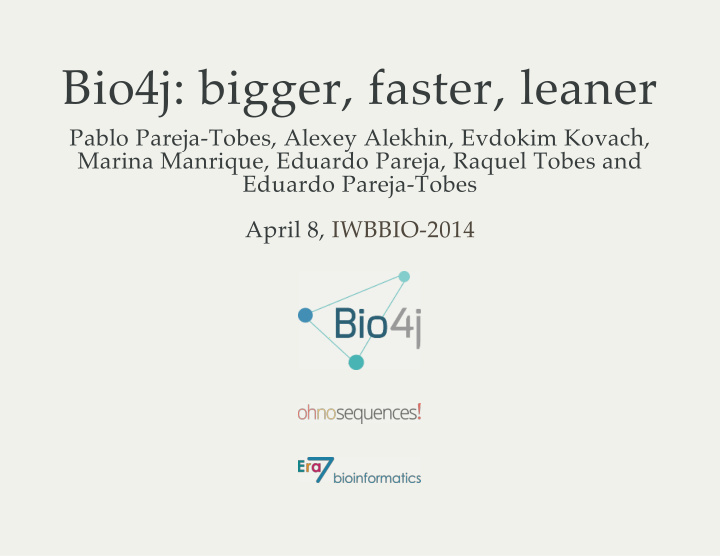



Bio4j: bigger, faster, leaner Pablo Pareja-Tobes, Alexey Alekhin, Evdokim Kovach, Marina Manrique, Eduardo Pareja, Raquel Tobes and Eduardo Pareja-Tobes April 8, IWBBIO-2014
Introduction
What is Bio4j? Bio4j is a bioinformatics graph -based data platform integrating the most representative open data sources around protein information
Data sources UniProt KB (SwissProt + Trembl) Gene Ontology (GO) UniRef (50,90,100) RefSeq NCBI Taxonomy Expasy Enzyme DB
It’s open! Code is under the AGPLv3 license Only Open Data is integrated Implementation & release process is 100% public and totally transparent
Biology & Databases today Highly interconnected overlapping knowledge spread over different data sources maintained in the Relational Databases or sometimes even just as plain CSV files That might be fine for simple scenarios but as the amount and diversity of data grows, domain models become crazily complicated!
Doesn’t look very compelling right?
Relational model With relational paradigm the double implication Entity ⇔ Table doesn’t go both ways, which implies auxiliary tables artificial IDs dealing with raw tables (in spite of entity-relationship diagrams) Integrating new knowledge becomes difficult
Biology ≠ Table Life in general and biology in particular are probably not 100% like a graph… but one thing is sure: they are not a set of tables!
Why graph databases? Data is stored in a way that semantically represents its own structure Incorporating new data is easy ⇒ it’s scalable Vertex-centric (local) indices allow to overcome the supernode problem
Why in the cloud? Data as a service Services interoperability Data distribution Backup and storage Scalability Cost-effectiveness
Bio4j = Bio Data + Graph Databases + The Cloud
Details about Bio4j
How it all started Need for massive access to Gene Ontology annotations BG7 bacterial genome annotation system Need for massive direct access to protein information More and more data! As other data sources were becoming a bottleneck they were integrated into Bio4j First it was Uniprot KB, then Uniref, … And we didn’t stop yet!
Different layers of Bio4j 1. Abstract domain model with precise typing 2. Universal Blueprints implementation 3. Technology-specific versions: Neo4j Titan (WIP) OrientDB (planned) Different graph topologies at the storage level, same domain model in the client’s code
Bio4j domain model 109 edges of 150 types 2 × 108 nodes of 40 types 6 × 108 properties
Bio4j structure The importing process is modular and customizable allowing you to import just the data you are interested in
Bio4j module system Statika helps to manage dependencies between modules and simplifies import and deployment in the cloud
Under the hood
How we use Bio4j in Era7 BG7 genome annotation MG7 metagenomics analysis Comparative genomics, network analysis, genome assembly, …
How others use Bio4j Ohio State University Integration and analysis of Chip-seq data Modeling genomic information and gene regulatory networks Berkeley Phylogenomics Group Graph database for Big Data challenges in genomics developed on top of Bio4j
How we develop Bio4j Java + Scala source code Statika -based module system SBT for building sources and automated tests & release Git + Github : versioning, docs, collaboration, coordination
Who’s doing Bio4j Ohnosequences! Era7 bioinformatics R&D group Pablo Pareja project leader & main developer Eduardo Pareja-Tobes technology & architecture Raquel Tobes bio data integration Marina Manrique bio data integration Alexey Alekhin module system developer Evdokim Kovach developer
Contacts @bio4j Twitter for news bio4j Github org for the development process bio4j-user Google group for the user feedback bio4j Linkedin bio4j.com
Thank you for attention! The source and the latest version of these slides can be found at github.com/ohnosequences/IWBBIO-2014
Recommend
More recommend